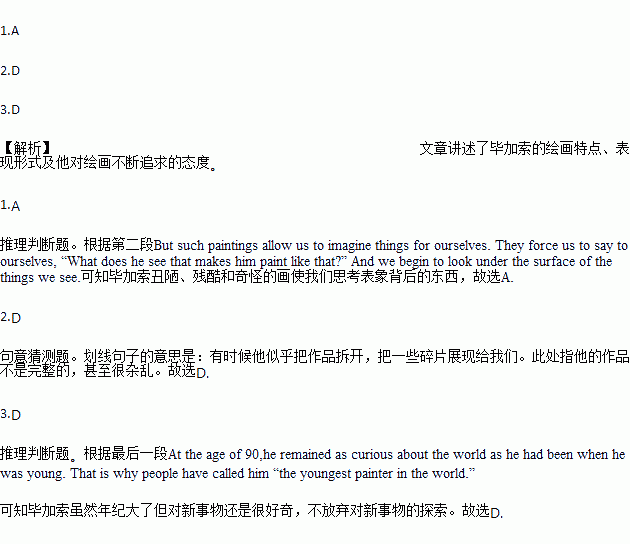题目内容
Most painters discover a style of painting that is fit for them and stick to that, especially if people admire their pictures. But Picasso, the great Spanish painter, was like a man who had not yet found his own particular style of painting. He kept on struggling to find the perfect expression till his death in 1973.
Some of Picasso's paintings are rich, soft colored and beautiful. Others are ugly and cruel and strange. But such paintings allow us to imagine things for ourselves. They force us to say to ourselves, “What does he see that makes him paint like that?” And we begin to look under the surface of the things we see.
Picasso painted thousands of pictures in different styles. Sometimes he painted the natural look of things. Sometimes he seemed to break them apart and throw the pieces in our faces. He showed us what the mind knows as well as what the eyes see. At the age of 90,he remained as curious about the world as he had been when he was young. That is why people have called him “the youngest painter in the world.”
1.The ugly cruel and strange paintings by Picasso _______.
A. make us try to notice something hidden in the things
B. allow us to ask questions about them
C. force us to question anything we see
D. cause us to think what Picasso saw was different from what we see
2.The underlined sentence “Sometimes he seemed to break them apart and throw the pieces in our faces” means _____.
A. sometimes he tore his pictures into pieces
B. he broke something he was painting and threw them away
C. sometimes he showed some broken pictures to others
D. things in some of his pictures seem to be in disorder
3.Why have people called Picasso “the youngest painter in the world?”
A. Because he observed things with the eye and the mind.
B. Because he looked young when he was old.
C. Because he never stopped painting he was old.
D. Because he never gave up looking for something new.
 新活力总动员暑系列答案
新活力总动员暑系列答案 龙人图书快乐假期暑假作业郑州大学出版社系列答案
龙人图书快乐假期暑假作业郑州大学出版社系列答案
